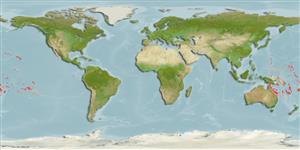>
Acanthuriformes (Surgeonfishes) >
Acanthuridae (Surgeonfishes, tangs, unicornfishes) > Acanthurinae
Etymology: Acanthurus: Greek, akantha = thorn + Greek, oura = tail (Ref. 45335).
More on author: Shaw.
Environment: milieu / climate zone / depth range / distribution range
Ecologie
marien rifbewoner; diepte 0 - 10 m (Ref. 27115), usually 0 - 4 m (Ref. 9710). Tropical; 28°N - 26°S, 143°E - 109°W
Western Pacific: oceanic islands of Oceania to the Hawaiian and Pitcairn islands. Also known from Wake, Marcus, and Mariana islands. Eastern Central Pacific: southern tip of Baja California, Mexico (Ref. 9267) and other offshore islands.
Grootte / Gewicht / Leeftijd
Maturity: Lm ? range ? - ? cm
Max length : 24.0 cm TL mannelijk / geslacht onbekend; (Ref. 9710)
Dorsale stekels (totaal): 9; Dorsale zachte stralen (totaal): 29-33; Anale stekels 3; Anale zachte stralen: 26 - 29. Dark brown, nearly black in color. Erectile spine (sharp and forward-pointing) on each side of caudal peduncle which folds down into a groove. Mouth small, snout noticeably extended. Light blue ring around chin and presence of spot of same color on gill cover at angle of gill opening. Dorsal fin with soft part having longer base than spinous part. Juveniles lack the large orange spot on caudal area.
Occurs in clear seaward reefs, usually in groups (Ref. 9710). Benthopelagic (Ref. 58302). Feeds on filamentous and small fleshy algae (Ref. 9267). Monogamous (Ref. 52884). Spine in caudal peduncle may be venomous. Size of metamorphosis from postlarva stage to juvenile is 6 cm (Ref. 9267). This species sometimes hybridizes with A. nigricans (Ref. 9808).
Levenscyclus en paargedrag
Maturiteit | Voortplanting | Paaien | Eieren | Fecunditeit | Larven
Monogamous mating is observed as both facultative and social (Ref. 52884).
Randall, J.E., 1956. A revision of the surgeonfish genus Acanthurus. Pac. Sci. 10(2):159-235. (Ref. 1920)
Status op de Rode Lijst van het IUCN (Ref. 130435)
Gevaar voor de mens
Traumatogenic (Ref. 4690)
Gebruik door de mens
Visserij: commercieel; Aquarium: Commercieel
Meer informatie
ReferentiesAquacultuurAquacultuurprofielKweeklijnenGeneticaElectrophoresesErfelijkheidZiektesVerwerkingNutrientsMassaconversie
Tools
Speciale rapporten
Download XML
Internetbronnen
Estimates based on models
Preferred temperature (Ref.
123201): 25.8 - 28.3, mean 27.4 °C (based on 404 cells).
Fylogenetische diversiteitsindex (Ref.
82804): PD
50 = 0.5000 [Uniqueness, from 0.5 = low to 2.0 = high].
Bayesian length-weight: a=0.02344 (0.01103 - 0.04981), b=2.96 (2.79 - 3.13), in cm total length, based on LWR estimates for this Genus-body shape (Ref.
93245).
Trofisch niveau (Ref.
69278): 2.0 ±0.00 se; based on food items.
Weerstandsvermogen (Ref.
120179): Hoog, minimale populatieverdubbelingstijd minder dan 15 maanden (Preliminary K or Fecundity.).
Fishing Vulnerability (Ref.
59153): Low vulnerability (14 of 100).
Nutrients (Ref.
124155): Calcium = 77.7 [33.7, 236.7] mg/100g; Iron = 0.837 [0.317, 2.103] mg/100g; Protein = 18.2 [16.9, 19.4] %; Omega3 = 0.0938 [, ] g/100g; Selenium = 13 [4, 39] μg/100g; VitaminA = 45.8 [10.8, 181.2] μg/100g; Zinc = 3.17 [0.99, 6.04] mg/100g (wet weight);
